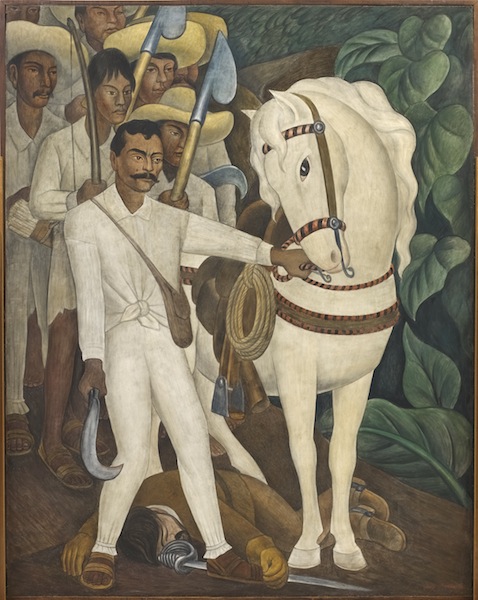The first Rivera exhibition at MoMA was their second one-person show (Matisse being the first), just as the horrors of the Great Depression were sinking in. The show consisted of eight 'portable' frescoes. The Museum organiser wanted New Yorkers to get a taste of the revolutionary murals that were springing up all over Mexico at the time. Mexican muralism emerged in the 1920's in the wake of a bloody 10-year old revolution that brought a Marxist-led government to power. Public buildings were adorned with murals that taught socialist ideals and celebrated Mexico's pre-colonial indigenous culture.
Rivera's exhibition at MoMa broke attendance records even with an admission of 35 cents during the Great Depression. People went mad for it and the show outsold Matisse by far.
The power of those frescoes was not just the fact that they were an integral part of the nationalist, radical Mexican revolution but also because they coincided with the establishment of the first workers' state in the Soviet Union and the fact that Rivera aligned himself with Trotsky and opposed Stalinism.
The paradox was that Rivera's social realism (secular, revolutionary responses to church frescoes) was an art for the people which he executed while enjoying the patronage of the most successful bankers of his time. Five of the frescoes were copies of murals that Rivera had made in Mexico: Sugar Cane, Liberation of the Peon, Agrarian Leader Zapata, The Uprising, Indian Warrior. The other three Rivera did during the uproar that followed the opening and were added during the six-month run of the show. The last and most ambitious is Frozen Assets which caused a second, even bigger uproar.
The Jaguar, (Guerrero Indio), 1931
An Aztec warrior wearing a jaguar suit is straddling a fallen Spanish conquistador. The large impassive eyes and the white fangs emphasize the determination of the man inside the suit as he plunges a stone knife into the armored man beneath him. The Spaniard's steel blade - the European's claim to superiority - lies broken nearby. The panel's vision of righteous violence referred to the recent Mexican revolution.
The Uprising (El Kevantiamento), 1931
A woman holding a baby and a working man fend off an attack by a uniformed soldier. Behind them a crowd clashes with more soldiers who force demonstrators to the ground - a potent symbol for universal class struggles.
Liberation of the Peon, 1931
A labourer, beaten and left to die, is cut down from a post by sympathetic revolutionary soldiers who tend to his broken body. Peonage - a system of servitude established by Spanish colonizers under which the natives were forced to work the land - persisted in Mexico into the 20th century. In the mural, connections are being made between what happened when Mexico was conquered and the on-going revolution in the 30s.
Agrarian Leader Zapata (Lider Agrario), 1931
Emiliano Zapata, champion of agrarian reform and a key protagonist in the Mexican revolution leads a band of peasant rebels who are armed with makeshift weapons, including farming tools. He stands above the body of a hacienda owner. An image of violent but just revenge.
Sugar Cane, 1931
In the foreground a woman cuts papayas from a tree while her children collect the fruit in baskets. A foreman, with lighter skin and hair watches over them on horseback while in the background an even lighter hacendado (plantation owner) lounges on a hammock.
Pneumatic Drilling, 1931
The figures in this mural use a pneumatic drill and a jackhammer to bore into New York's foundation. When Rivera arrived in New York the city was in the throes of the greatest construction drives of all time, made possible by the armies of surplus labour that were available during the Depression.
Electric Power, (Energia Electrica), 1931-32
Situated just below New York city's jagged skyline, a steel and cement power plant interior - deep in the inner workings of the city are to be found the workers that power that city.
Frozen Assets (Fondos Congelados), 1931-32
In this mural Rivera launches into a critique of the inequality of New York society. The upper panel features a sequence of easily recognisable skyscrapers. Just below that, are the masses trudging to work. In the next section a steel and glass shed serves as shelter for rows of sleeping men (overseen by a hudrant shaped policeman), pointing to the dispossed labour that made possible the city's extraordinary growth at a time of economic upheaval. Below, in the bank's waiting room are a clerk, a guard and three figures eager to inspect their mounting wealth in the vault inside which, another figure is doing exactly that.
(We were not allowed to take photographs so the photographs of the above paintings have been downloaded).
Flower Festival: Feast of Santa Anita (Festival de las Flores: Fiesta de Santa Anita), 1931, (encaustic on canvas)









A fine exhibition
ReplyDeleteThis comment has been removed by the author.
ReplyDelete